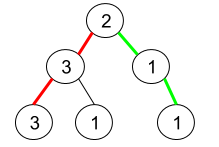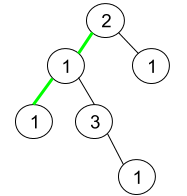⭐️⭐️⭐️
# 題目敘述
Given a binary tree where node values are digits from 1 to 9. A path in the binary tree is said to be pseudo-palindromic if at least one permutation of the node values in the path is a palindrome.
Return the number of pseudo-palindromic paths going from the root node to leaf nodes.
# Example 1

Input: root = [2,3,1,3,1,null,1]
Output: 2
Explanation: The figure above represents the given binary tree. There are three paths going from the root node to leaf nodes: the red path [2,3,3], the green path [2,1,1], and the path [2,3,1]. Among these paths only red path and green path are pseudo-palindromic paths since the red path [2,3,3] can be rearranged in [3,2,3] (palindrome) and the green path [2,1,1] can be rearranged in [1,2,1] (palindrome).
# Example 2

Input: root = [2,1,1,1,3,null,null,null,null,null,1]
Output: 1
Explanation: The figure above represents the given binary tree. There are three paths going from the root node to leaf nodes: the green path [2,1,1], the path [2,1,3,1], and the path [2,1]. Among these paths only the green path is pseudo-palindromic since [2,1,1] can be rearranged in [1,2,1] (palindrome).
# Example 3
Input: root = [9]
Output: 1
# 解題思路
# Solution
import java.util.Stack; | |
class Solution { | |
private int ans; | |
public int pseudoPalindromicPaths(TreeNode root) { | |
ans = 0; | |
Stack<Object[]> stack = new Stack<>(); | |
stack.push(new Object[]{root, 0}); | |
while (!stack.isEmpty()) { | |
Object[] tmp = stack.pop(); | |
TreeNode curr = (TreeNode) tmp[0]; | |
int val = (int) tmp[1]; | |
if(curr != null){ | |
val = val ^ (1 << curr.val); | |
if(curr.left == null && curr.right == null){ | |
if((val & (val - 1)) == 0){ | |
ans++; | |
} | |
}else{ | |
stack.push(new Object[]{curr.left, val}); | |
stack.push(new Object[]{curr.right, val}); | |
} | |
} | |
} | |
return ans; | |
} | |
} |
單字
** **
!! !!
片語 & 搭配詞
!! !!
